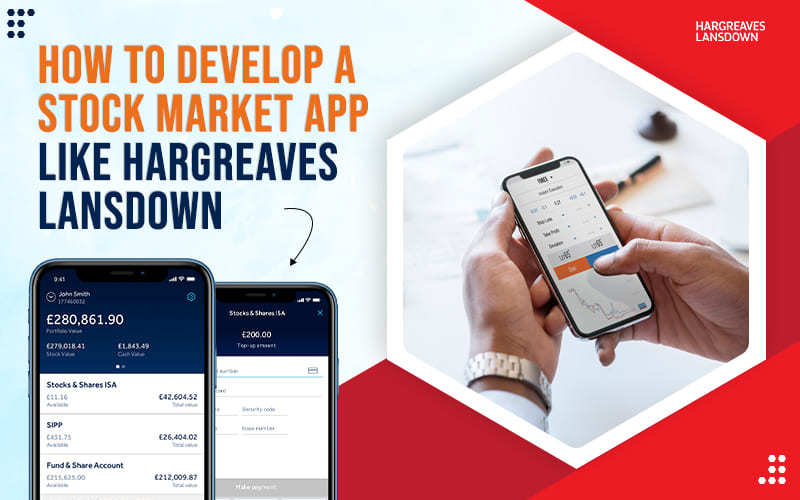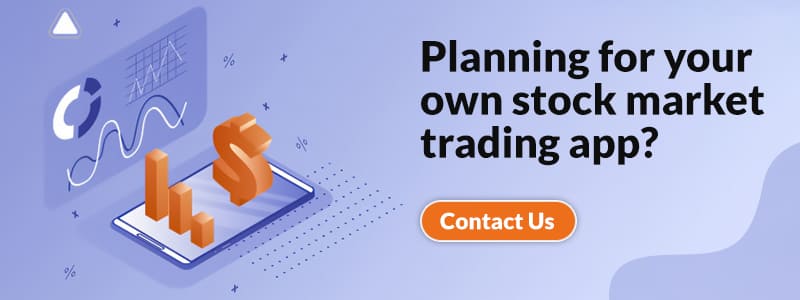How to Develop a Stock Market App like Hargreaves Lansdown?
With the overall growth in salaries and money, more and more people are getting inclined towards the stock market. The stock market offers various ways to grow one’s wealth and is hugely popular amongst adults from all generations. Under the given situation, some may even argue there’s nothing better than starting a stock market app, and we couldn’t agree more.
Stock market apps like Hargreaves Lansdown are seeing a massive user base in very little time, and if you want to grab the opportunity as well, you need to know how to develop a stock market app.
We would take you through the journey of getting your own stock market app developed and the decisions you would need to make. There can be many aspects to look at, but we recommend you take the blog to self-access the app you are planning and make additions/changes required to make it successful.
How to develop a stock market app like Hargreaves Lansdown?
Step 1: Making a List of Features
You are creating a platform for trading the same assets, so the first and foremost question you need to ask yourself is, what would be the key differentiator? The features you offer in your stock market app. Making an app like Hargreaves Lansdown is an excellent idea, but you need to include more features if you want to compete in the market. Something as simple as a widget can be a game-changer here, but you need to figure that out first. We have put together a list of features to include while developing a stock market app; this will give you a headstart.
a. Financial Advice
The best feature which new joiners or novices would love to have is financial advice. We know it doesn’t sound right as there would be real money at risk, but try to find a way through which it can be implemented. Something as simple as adding videos from trusted TAs can be a part of it, and while it can go both ways, the probability of it going in favour is a bit more.
The fact that not a lot of people understand the stock market is what we are trying to leverage here. They just want to invest. This feature would add professional advice to follow or not is at the discretion of the customer. Some apps do provide this feature, but it is an area in which you can truly excel by introducing your own game plan to the app you create.
b. Structured Trade Finance
Structured trade finance or STF isn’t a new addition to the world of trading but is a must-have if you focus your app on a more general audience. STF would help people invest their funds directly with an entity that would control the entire allocation of funds. STFs are tougher to monitor with generic apps, so building a good structure to implement it is a basic necessity.
c. Widgets
People dealing in the stock market love to keep a watch, and the best to do it through widgets. While it may seem like overkill to put it in this list, many apps do not actually offer widgets or certainly don’t keep up with OS updates. For a successful stock trading app, make sure you put a huge focus on widgets, as they would be solving the purpose for which people would be using your app. Live price watch should be directly integrated into widgets and be presented in the most subtle way possible.
d. Payment Options
Including as many payment options as possible is the key to attract a large user base. The particular ones you would like to include should be popular neobanks like Revolut. You would also need to add secure payment gateways right into the app; people would absolutely love an easy stock buying experience. While there may be regulation around buying assets with debit/credit cards, you can always enable fiat deposit options through banks.
e. Peer-to-Peer
This feature is somewhat controversial, as it may lead to compliance issues based on the country you want to target for your app. Featuring a peer-to-peer network can make things much simpler for users once there are enough users in the system. Not that it would make a very major difference, especially if you are offering a good quality exchange, but it can change things if implemented correctly.
f. Push Notifications
Push notifications for price movements, new stock announcements are major features to include in your stock market app. They are a way to keep people engaged in the general scenarios, but it is all the more different with a stock trading app. Balance the notifications for important information that could drastically improve your application’s customer experience and value.
g. Support
We cannot emphasize enough how much you need to have a live support option if you are considering entering the stock market trading app business. You can combine it with a chatbot which would also serve as an educational one, hitting two birds with one stone. You can assist people using the same chatbot and solve their queries as early as possible; time is money, after all, in the stock market.
h. Security
With an app involving huge sums of money, you should always keep your primary focus on security. Elements like 2FA through apps like Google Authenticator are a must-have feature and highly recommended if you plan to develop a stock market app. Other features like fingerprint/face ID login and a separate withdrawal password can be added to add an extra layer of security while developing your stock trading app.
Step 2: The Development Part
Whether you choose a mobile app development company or build your own team, it is always better to know the possibilities when it comes to technology. You would have the biggest choice between getting Native apps developed or going with Cross-platform app development. While the consultants would explain to you the pros and cons of both, this decision is yours to take, as it will highly affect cost and development time.
The major decisions you would be making includes:
a. The Platform for Mobile App Development
Native applications: This is the expensive option for developing a mobile app and is the most capable option available. While we would generally not recommend Native app development in the current scenario and cutthroat competition, stock trading apps are different. You would need maximum scalability, performance, and security when building your stock market trading app, and Native is certainly the way to go for it.
Cross-platform application development: Cross-platform apps come up with the concept of code reusability and are a faster and cheaper way to build apps for both iOS and Android operating systems. We don’t really recommend cross-platform app development for stock trading app development as they require extra features and safety measures compared to generic applications.
b. Choosing Team Members for your Stock Market App’s Development
You would need experts when developing a stock market app; there will be major dependencies if you implement features like STF and P2P. Consider someone like us if you are serious about getting the app perfect in one go; our project managers have decades of experience building highly complex applications and can help you with all your requirements. The overall team you would require to develop a stock trading app would be:
- A Project manager
- App developers
- UI/ UX experts
- QA and testers
- Digital marketers
c. Technology Stack
Scalability and quick transactions are the way to go with a stock trading app. There are various combinations available to achieve that, but you need to perfect them as a huge amount of money will be at stake. With time and money both at risk, you should choose a technology stack that can handle all the pressure without cracking down. The choices you would be presented when getting your stock trading app developed would be:
1) Native App Development
- Swift (iOS development)
- Android Studio (Android development)
2)Cross-platform app development
- React Native (Cross-platform development framework)
- Flutter (Cross-platform development framework)
- Ionic (Cross-platform development framework)
- Xamarin (Cross-platform development framework)
3) Data analytics tools
- Python
- Java
- Amazon EC2
- Amazon S3
- Kafka
- Scala
- Amazon VPC
- Amazon EMR
- Apache Impala
4) Utilities
Elastic Search
5) DevOps
- Chef
- AWS CloudFormation
6)Databases
- Aerospike
- MongoDB
- Cassandra
- HBase
- MySQL
- Postgre
Recommended Read : A Complete Guide to Fintech App Development
Step 3: Who to hire?
a. Setting up your own team
This is the most expensive and dicey way to develop a stock market app, as you would need very highly experienced developers and project managers to pull it off. Had it been a simpler project, you could have simply set up a small team and gone through with an app that works. But in the case of stock market trading application development, you need experts to pull it off perfectly.
b. Hire freelance developers
Again, as we exclaimed above, you need majorly experienced developers on the job, which usually isn’t possible with freelancers. It is a great way to expand the team and reduce workload, all while saving tons of money, but it just won’t work with the extreme demands of a stock trading application.
c. Hire an app development company
We recommend this option, but you will have to do your research on finding companies with expertise in finance software development. You can get a perfect app if you find the right development house to build it, and it won’t even break the bank for you. We at Matellio have expertise in creating apps like Hargreaves Lansdown and can help you build your own stock trading app with ease.
Are you ready to develop your own stock market application?
We at Matellio help clients expand, improve efficiency, and grow more reach through the apps we build for them. Our stock market app development and finance software development expertise make us the perfect fit for the job. If you are looking forward to developing your own stock market application, just reach out to us, and we would be happy to make it a reality for you.






